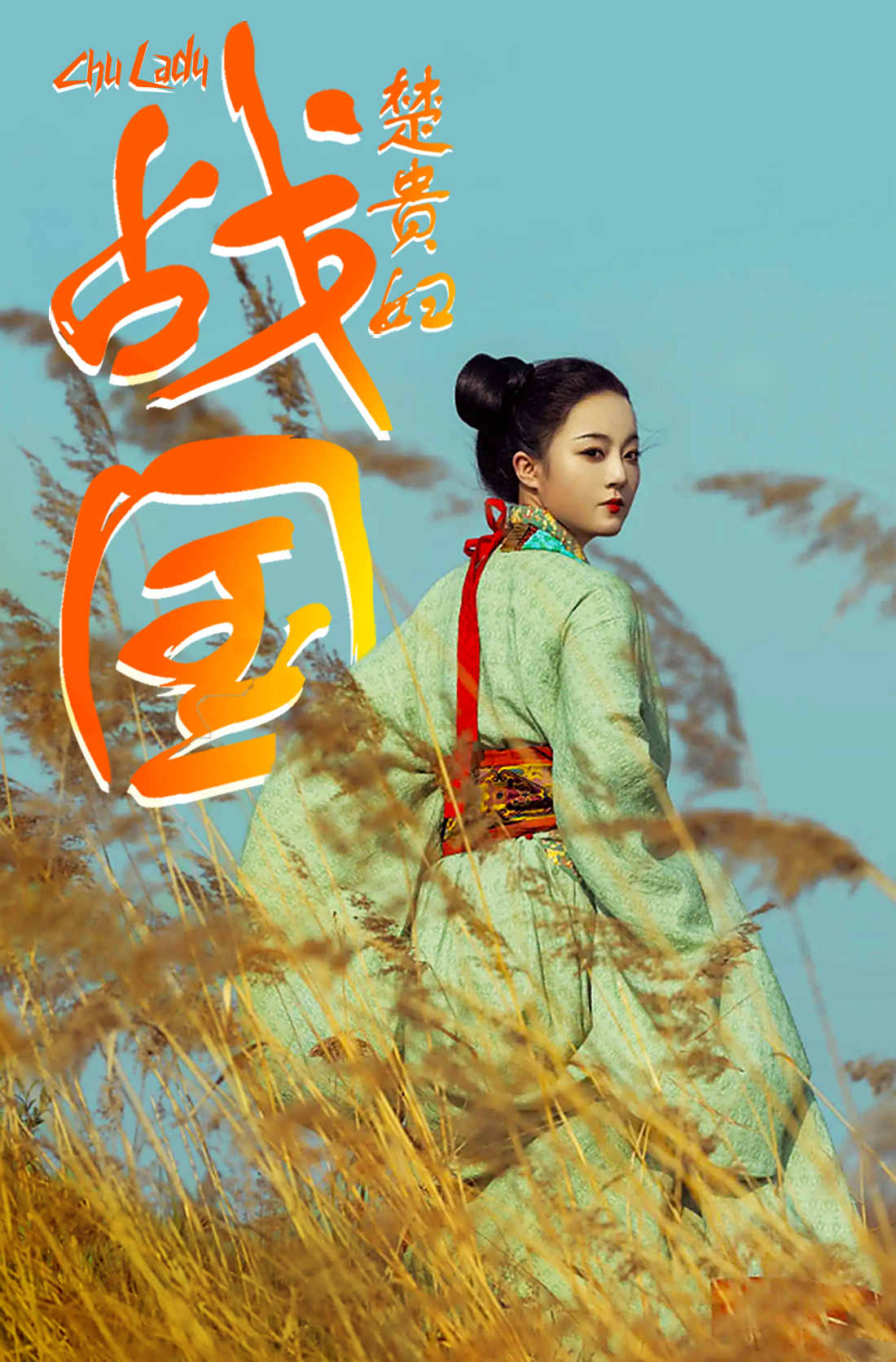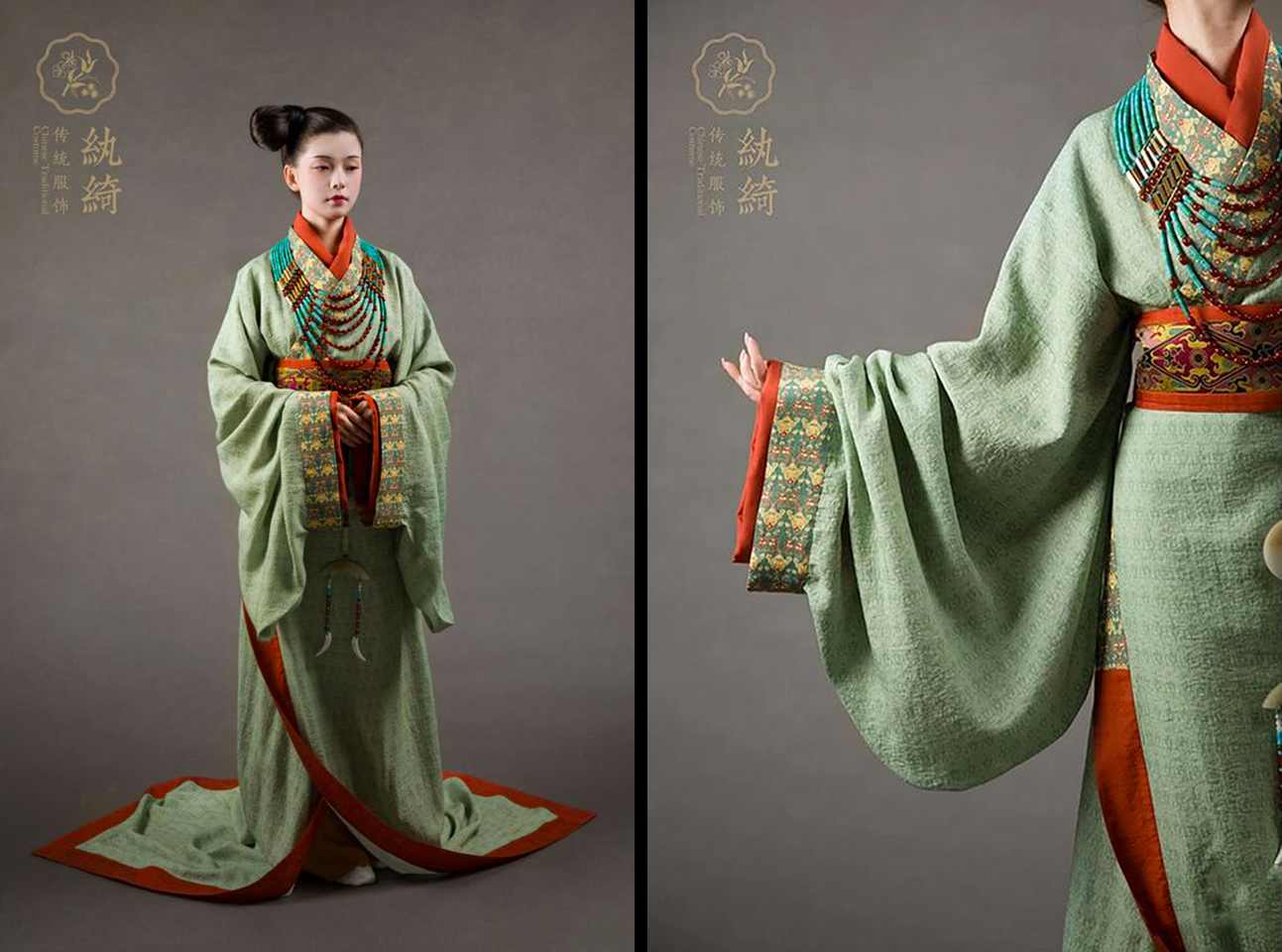Warring States Lady- A Lady of Chu (475–221 BC) : 战国- 楚贵妇
Reenactor: 青林白鸟
A lady of Chu- Warring States period (475–221 BC) she wears an elaborate necklace of ornate turquoise and other beads made of carnelians. Her silk robe was likely worn by the noble court ladies of this era. Reconstructed based on the archeological example from No.1 Chu tomb of Mashan in Jiangling- Hubei Province, China.
THE PROUD CHU- AMONG THE FIRSTS, UNTIL THE LASTS
The Lords of Chu were vassals of the Zhou kings and once were supposed to crush the myriad of southern tribes, instead, they went native. Instead, they came back as their Kings. Full chapter covering the origin of Chu and its brief rise to hegemony in the Spring and Autumn period here. In the thorn- choked thickets and torrential rivers of the south. The Kings of Chu adopted the family name Mi, yet the rulers retained the surname Xiong 熊 (lit. "Bear,") and led hundreds of tribes that violently shunned the Zhou ways.
Chu eventually became one of the strongest kingdoms in both the Spring and Autumn period and also the Warring States period, they were there in the beginning at Zhou's founding and more than 800 years later was one of the last and most important kingdoms to fall to Qin right during the conquest of the first Emperor. A brief chapter that covers Chu's loss of critical initiative during the Warring States period could be found here.
Music: Gone with Leaves

Chu- although it was enfeoffed during the founding of the Zhou, and its ruling clan proclaimed they possessed Central Plain ancestry, but the people of Chu spoke a distinctly different language and had different customs. At the time, the common language of the Zhou- that of the Zhou court aristocrats 雅言 Yayan (lit: "Elegant Speech") was very different from these Southern dwellers: the language of Chu distinctively denoted as 楚言 Chuyan (Chu Speech) was incomprehensible to both the Zhou ears and in diction. Zhou people revered the spirits of their ancestors while the Chu revered animals.
Clothing Maker: 纨绮传统服饰
The preferences of those 2 peoples differed as well, Chu honored the left hand during greetings, while Zhou the right, Zhou reveres the dragon, Chu reveres the phoenix. Zhou society stressed that people conduct themselves according to Li 禮 ~ a (cosmic) order of propriety (and offending such order will provoke the wrath of Heaven ala the the Mandate of Heaven), where one should learn one's place and act accordingly within the social network and hierarchy, -such good form is the order of things (later crystalized into Confucianism) while the people of Chu had no pretense for this world view.
Thus, even beyond the realm of politics, Chu were seen as the outsiders to the Zhou political order. Despite this, the Chu eventually partially assimilated to Zhou ways at their discretion and instead as Zhou royal authority weakened, Chu rose to became one of the greatest states of the Spring & Autumn and Warring States period.
SILK, GOLD, AND LACQUER
What's more, although Chu began as merely a semi- Sinicized "barbarian" vassal of Zhou, after having made itself a rich and militarily formidable kingdom it soon became a major cultural and economical power house as well, as both attested by historical records and rich grave material culture.
Chu by the Mid Warring States Period: Qin (black,) Qi (red,) and Chu (green,) were the 3 major poles of this age and Qin and Chu both had an army around 1,000,000 strong.
The state was known for its quality of silk, gold, and lacquerware- some of the most ornate from East Asia in this age. Lacquered drum with and bird and tiger frame shown below, Chu-state, from Spring and Autumn period. Recovered rough framework (Above,) similar elaborate wooden sculpted example (Middle,) and Reconstruction with restored lacquered coloring (Below.)
Thank you to my Patrons who has contributed $10 and above: You made this happen!
➢ ☯ MK Celahir
➢ ☯ Muramasa
➢ ☯ Thomas Vieira
➢ ☯ Vincent Ho (FerrumFlos1st)
➢ ☯ BurenErdene Altankhuyag
➢ ☯ Stephen D Rynerson
➢ ☯ Michael Lam
➢ ☯ Peter Hellman
➢ ☯ SunB
Related: A Western Han Dynasty gentleman in similar style of clothing. Several centuries apart







.jpg)



.png)




.png)



.jpg)

%20(1).jpg)
-.jpg)



.jpg)


%20(1).jpg)



Comments
1. The Chu were early vassals of the Zhou, what feudal rank (公, 侯, 伯, 子, 男) did they hold before they perversely took the title of King?
2. These Chu fashions don't seem to conform to the climate of southern China, a lot of layers like their northern cousins. Why didn't the Chu fashions come to resemble those of the Thai, Indians and Khmer more ... less layers, more skin showing. I'm sure it would be more comfortable in the hot and humid region. These northern Chinese fashions are like Victorian men and women in their English attire of heavy suits and frumpy dresses in the heat of India!
3. Qin and Chu had 1 million man armies each? is this plausible? The Roman Empire at its height under Trajan had only 300,000 legionaries and auxiliaries.
4. Do you think Chu made a mistake conquering Yueh and Wu when it should have prevented itself from being outflanked by Qin in conquering Ba and Shu? It seems the Sichuan Basin is more naturally a part of Chu rather than Qin.
5. This issue of ancient language is interesting. How did these elites of ancient China communicate? Ancient China is like modern China, with Chinese coming in many forms and dialects. Like Europe, it's a subcontinent with many countries and cultures during the latter Zhou period. European diplomats and statesman spoke Latin, then French and eventually English as a lingua franca, ... was there a lingua franca for Zhou statesman and diplomats?
Obviously they didn't have a million man army each, not until World War I was that possible. Treat numbers in pre-modern chinese historical records with a huge grain of salt. Usually the more ancient, the more unreliable, but not always. Often the ones writing the records were civilian officials with little knowledge of military affairs who would literally round up the numbers. So you have 48600 men? Eh, that doesn't roll off the tongue, let's put 50 thousand on paper. But sometimes you get actual military men who recorded things, those are usually much more accurate, numbers wise anyways.
This is true but that's one of the reasons I qualify say~ An Lushan Rebellion stats and Spring and Autumn and even most of Sima Qian's numbers as more liberal estimates, and try to recontextualize with more probably numbers. IE what was 1st mentioned and followed by the likely numbers.
However doing that each time a stat is brought up would be very tiring especially since the range of topic covered spans from ancient to 1912. What's more I believe modern scholarship by default look at a lot of those figures with a grain of salt- Alexander the Great's enemy's figures, Xerxes Thermopylae figures etc.
Perhaps in the future there could be a qualifier whenever I automatically encourage a healthy amount of skepticism to these figures but if I do it every single time it might creates a meme-y unilateral impression that all CN figures regarding history is not reliable.
1. Viscount
2. This dress is from the very late part of Chu's lifespan, after they had long familiarized with the Zhou culture of the Central Plains- a process as early as King Zhuang of Chu. In many ways Chu had been well familiar with the trappings and norms of that culture.
3. No, but Han retroactive figures are quite a trouble to deduce because they ballpark their figures and do not offer methodology for their estimates of great battles say~ centuries prior and those even before that. The only work around is cite what Han historians estimated then try to deduce likely numbers.
4. Well this is with hindsight. Though I will say Chu ancestral lands are more to what was the west of Chu and not the eastern expanses like where Yue was. As for trying to focus on Qin more? I mean I do agree but that's again with hindsight. Honestly they should have been more assertive with the 5 kingdom alliance against Qin at Hangu and continued to sponsor policies that trapped Qin inside their domains and not get their eyes off the ball until Qin is weakened enough that there's parity for Chu to shift its attention else where. Still, Chu did make Qin a target after it was betrayed by Zhang Yi. During much of the future King Zhaoxiang's youth his mother and her powerful court bloc prevented him and Qin from turning on Chu- her homeland. But he eventually usurped her and made for Chu. The fact Chu lost both its major reform initiatives (Wuqi) lost its initiative to Qin betrayal (Zhang Yi) and lost its parity with Qin is quite an object lesson. Though in a grand sense Chu did kind of get its revenge in Xiang Yu and Liu Bang- both were Chu "loyalists" ironically as per this exact question, both of these Chu loyalists were born in the area in Jiangsu and Zhejiang that were part of Yue.
5. I don't really look up ancient languages. I personally do like to study various modern languages- after all English is not my native language and years ago I cannot speak a word of it, but ancient languages etc's not doing much for my interest because I (just personal opinion) see very little practical utilities in the modern world. Better than I learn coding and AI with my paltry free time instead.
But here's something that might answer your questions:
https://en.wikipedia.org/wiki/Classic_of_Poetry
Book of Songs, Book of Odes is atm the oldest collection of Chinese poems and writings and you might satisfy your mind with it.
How were these ranks distributed and determined? Where were Song and Lu rulers Dukes while Chu and Qin were Viscounts?
The 2nd part was that some time after they became tutors to the future Zhou lords. One Yu xiong (熊 Xiong his name literally meant "Bear") was the tutor of the future King Wu that overthrew Shang and founded the Zhou as the next ruling kingdom and enfeoffed a realm of new lords that were either related to the Zhou kings or had rendered meritorious service. However King Wu's reign was brief and he died within 2-3 years after his ascension. After the Rebellion of the 3 Guards were swiftly put down in time the next King Cheng rewarded Yu Xiong's grand grand son as Viscounts, and minister of rites and portioned the lands in the south to them- in what is southern Henan and (in time) northern Hubei. By then the clan had taken up the last name of "Xiong" (Bear) and made it their last name. Mi in Chu dialect means Xiong as well, so Mi and Xiong were interchangeably used.
There they built the first Chu capital and maintained their vassalage to Zhou until King Zhao of Zhou tried to crush them 2 generations later and was in return utterly crushed. From there Zhou royal authority began to wane and mostly faded when King You of Zhou was slain when the Rong sacked Western Zhou's capital. Inversely, Chu's real destiny began and made itself one of the foremost players in both the Spring and Autumn period and then the Warring States period.